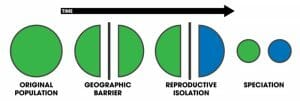A species is a group of organisms that can create new individuals that are fertile, and thus, can produce even more offspring. Therefore, two organisms that cannot reproduce and create fertile offspring are different species. The term speciation refers to the origin of new species. Allopatric speciation and sympatric speciation are the two major mechanisms by which new species form.
Comparison Chart
| Allopatric Speciation | Sympatric Speciation | |
|---|---|---|
| Is geographic isolation needed? | Yes | No |
| Major differentiation mechanism | Natural selection | Polyploidy |
| Speed of creation of new species | Slow | Autopolyploidy – fast; allopolyploidy – slow |
| Common in nature? | Yes | Yes – in plants |
| Examples | Darwin’s Finches; squirrels in the Grand Canyon | Cultivated corn, wheat and tobacco |
Allopatric Speciation
Allopatric comes from the Greek words allos meaning “other” and patris which means “fatherland.” Allopatric speciation occurs when a population of organisms becomes separated or isolated from their main group. Over time, the allele frequency in the new group, which used to be homogenous across the individuals, becomes subject to changes via natural selection due to of pressure from differences in predators, climate, competitors and resources. Populations can become isolated for a variety of reasons. Some examples are changes in land topography resulting from earthquakes, seeds dispersed by the wind and carried away in rivers, flooding, migration and erosion. Two examples of allopatric speciation are Darwin’s Finches and populations of squirrels in the Grand Canyon. Research has shown that the greater the distance of separation, the greater the odds that speciation will occur.

The image above illustrates the process of allopatric speciation.
Sympatric Speciation
The term sympatric comes from the English prefix sym- meaning “same” or “together” and the Greek word patris which means “fatherland.” This type of speciation happens in a population without geographic isolation. The main mechanisms resulting in sympatric speciation involve changes in the chromosomes of the organism. One way this happens is when there is a serious error that occurs during cell division resulting in more than one copy of a chromosome(s), or the loss of a chromosome(s), in one of the daughter cells. This condition is known as aneuploidy and there are two main kinds:
Autopolyploidy
In this situation, an organism has two or more sets of chromosomes of their own species. This normally happens in plants and results from all the chromosomes moving to one of the daughter cells during meiosis. When this happens, the resulting gametes will not be compatible for reproduction with those of either parent. However, the organism can self-pollinate or reproduce with another organism like itself that has the same number of chromosome pairs.
Allopolyploidy
The allopolyploidy form of sympatric speciation is created when two different species mate and create an offspring. The resulting gametes of the first-generation offspring must combine with normal gametes from one of the two original species to form viable offspring. The history of nearly 50% of all plant species can be traced back to a polyploid species. Examples of these are cultivated tobacco, cotton and wheat.
References
- OpenStax, Biology. OpenStax. May 20, 2013. http://cnx.org/content/col11448/latest/
- Sympatric Speciation. (n.d.). In Wikipedia. Retrieved June 4, 2017 from https://en.wikipedia.org/wiki/Sympatric_speciation
